Best of Both Worlds: The Nikon D780 Gives You the Best of the D750 and Z6
![]()
A little over 2 years ago, I did some extensive testing of the Nikon D5, D750, D810 and the then-newly released D850. The comparison was to determine which was the best camera for night photography.
Then, in September 2019, Gabe wrote a post exclaiming hands-down that “the Nikon Z 6 is the best camera for night photography.” I’ve had a few opportunities to use the Z 6 at night since then, and it’s an awesome camera for sure.
![]()
Then I recently had the chance to work with the newly released Nikon D780, courtesy of B&H Photo. It’s widely reported that the Z 6 and D780 share the same sensor, and the comparative images I’ve shot indeed look very similar. But there is one subtle difference that makes the image quality of the D780 ever so slightly better than that of the Z 6, especially for night photography in extreme low light. More on that later.
This rundown of the D780 is not intended to be a general review for everyone considering a new camera, but is rather tailored to the needs of the night photographer. If you are a wedding, wildlife or sports photographer, or someone who shoots a lot of video, then my review may be of limited usefulness to you.
In this article, I’ll evaluate the camera based on image quality at high ISOs in extreme low-light situations, for long exposures, and also in mixed artificial low-light situations typically found in urban areas at night. I’ll also be discussing the various features and functions as they relate to night photography in general.
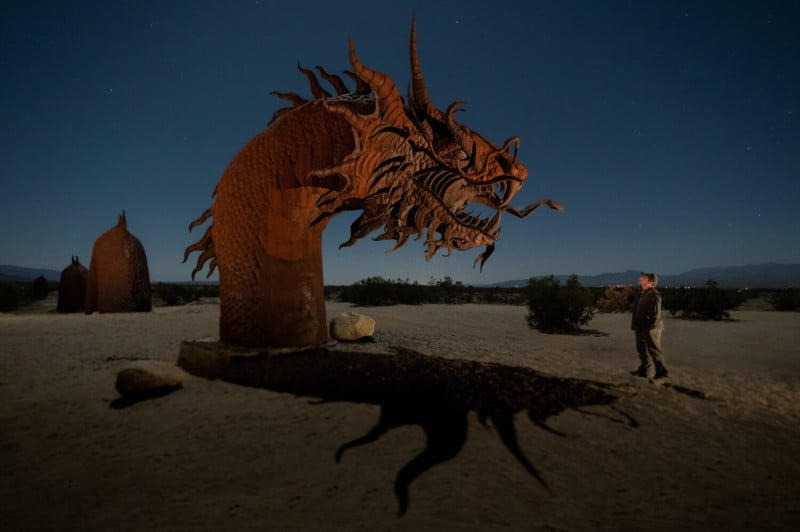
Key Features
The camera features a 24.5-megapixel FX-Format BSI CMOS sensor and EXPEED 6 Processor, which is reported to be the same sensor as that of the Z 6––with one slight modification.
Similar to its predecessor, the D780 features a tilting screen. The 3.2-inch, 2.36m-dot LCD is also a touch screen that functions well for intuitive control over playback and menu navigation, as well as touch control over autofocus and shutter functions. It would be nice if the screen had an articulating arm; as it is, the tilt screen is of limited usefulness in the vertical orientation, but is great for working from high and especially low angles in the horizontal orientation.
![]()
The D780 sports dual SD memory card slots like the D750, rather than the single XQD slot of the Z-system cameras. The former supports both overflow recording and simultaneous recording on both cards for peace of mind. It also accommodates the UHS-II standard, enabling fast write speeds for video and multi-shot sequences.
When used with the D780, the EN-EL15b lithium-ion battery is rated for an impressive 2,260 shots per charge without live view enabled, or 360 with live view. The battery can be charged via USB-C. For comparison, I recently got 554 25-second exposures out of a relatively new battery in the D750 (with live view and playback disabled) when shooting the Lyrid meteor shower.
The camera has variable aspect ratios of 1×1, 3×2 and 16×9, an in-camera monochrome mode, meter capabilities down to -3 EV, and shutter speeds down to 900 seconds (or 15 minutes).
Long Exposure
Yes, you read that right. Hallelujah! We finally have a Nikon DSLR with onboard shutter speeds that go beyond 30 seconds. There is a menu setting to enable extended shutter speeds, but once you turn it on, it’s a sticky setting, unlike Canon’s awkward Bulb Timer mode on the 5D Mark IV that requires going to the menu every time you use it.
We night photographers would have preferred even longer shutter speeds, but the D780 does have the Time mode, which, unlike the D750, does not automatically shut off at 1,694 seconds. Camera manufacturers have long been reticent to have programmed long-exposure times out of fear of long-exposure noise.
The primary implication of the extended shutter speeds is the elimination of the need for an external intervalometer in many situations. The extended shutter speeds combined with the internal intervalometer (or the easier-to-use but more limited self timer) allow for shooting stack sequences up to 2 hours, 15 minutes with the self-timer and virtually any length with the internal intervalometer.
I’ve been using the Time setting on the D750 and D850 and timing exposures either with my phone, or more often just by feel, because I never liked dealing with the fiddly and fragile intervalometers. For many night photographers, the onboard long shutter speed is a game-changing feature, even if it is only a convenience and has no effect on image quality.
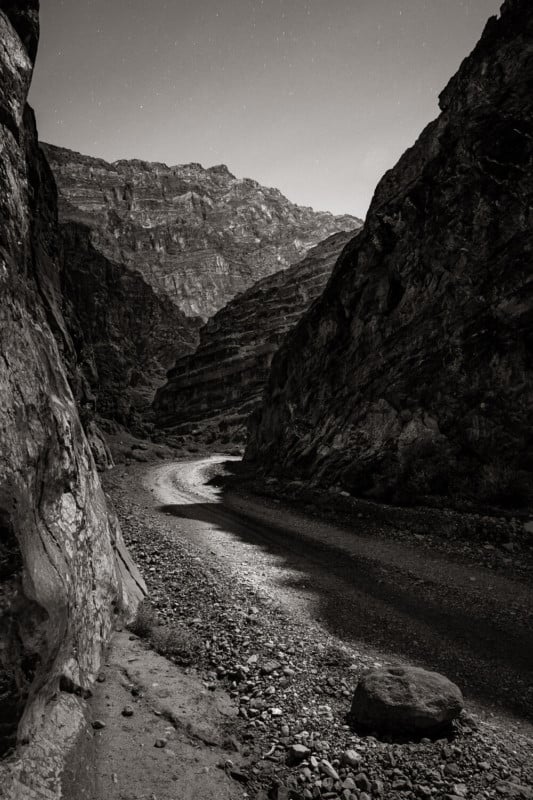
Autofocus
One of the things that has improved the most over the D750 is autofocus performance in both the viewfinder with a 51-point autofocus system, and also a hybrid system for live-view focusing. The hybrid system is adopted from the Z-series cameras, and switches between phase-detection and contrast-detection autofocus based on conditions. It covers approximately 90 percent of the frame with 273 focus points, making it easy for the camera to focus on subjects at the edges.
There is a low-light autofocus mode that extends autofocus capabilities down to -6 EV. The viewfinder autofocus system is accurate down to -3 EV. Under ideal conditions, this should allow for autofocus with live view in light as low as a quarter moon, and with the viewfinder under the light of a full moon. But autofocus on the Milky Way core is a long ways off still, as it is about -10 or -11 EV.
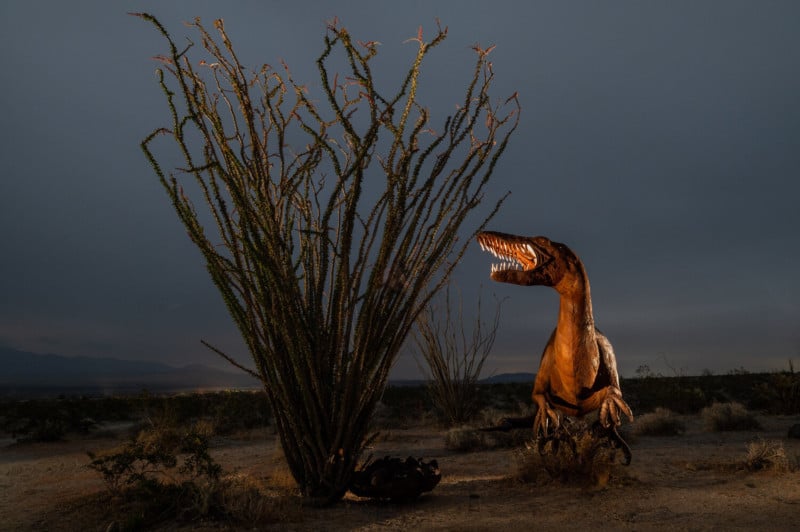
Live View
The live view interface is derived from the Z 6. It’s mostly familiar for Nikon DSLR shooters, but requires a little getting used to. The good news is that live view image quality in low light is much improved, and focusing on stars, or on dark foreground subjects with a flashlight, is much easier than with older Nikons.
I did find that I got the best live view image in low light conditions using the video mode set to the slowest possible shutter speed, just like with the D750. This is a workaround—not an ideal field workflow—as you must remember to turn off the live view before taking the picture, or the RAW file will be cropped to the 16:9 aspect ratio. Still, it is a big and welcome improvement.
![]()
Customization
A customizable 12-position menu can be accessed by pushing the i button on the back of the D780 or tapping the i icon in live view. The i menu is an easily accessible place to store settings that you change frequently. The camera allows users to customize different i menus for shooting stills through the optical viewfinder, for shooting stills in live view and for shooting video.
The D780 offers two customizable buttons on the front of the camera that can be set to any one of a long list of functions; you can view them all here. Additionally, the AF-On and AE-L/AF-L buttons can be customized, and the bracket button on the front of the camera can also be customized to shoot multi-exposure images or HDRs.
![]()
Build Quality
Comfortable in the hand and familiar to any Nikon user, the D780 offers a solidly built camera with full weather sealing in a relatively lightweight body. On first glance, it looks very much like the D750, but is just a little smaller with a few button changes. For a full-frame DSLR as capable as the D780, it’s compact and ergonomic. It’s basically a D750/Z 6 hybrid.
A Few Random Features
The live view activation button has been moved up to the right of the viewfinder, and the video record button is on the top deck, next to the newly located ISO button.
These changes require some adaptation, but the new position of the ISO button will be familiar to users of the newer Nikon cameras. It is a better and more logical position than on the D750, which has it second from the bottom on the button stack to the left of the rear LCD. Testing the D780, I inadvertently activated video recording several times while reaching for the ISO, but my fingers learned relatively quickly which button was which.
![]()
I know that I said I wouldn’t talk about video in this review, but quickly: Video shooting is much improved, and the D780 can shoot UHD 4K at up to 30 frames per second, or HD at up to 120 frames per second.
Moreover, there is now the option to create time-lapses from images shot with the Interval Timer Shooting mode instead of the Time-Lapse Movie option of the D850, which means you can keep the RAW files and still produce an in-camera time-lapse on the go. The D780 also has the same focus stacking mode as the D850.
The D780 is compatible with most Nikon F-mount lenses, including AI-S and all Nikon AF models.
On the negative side, there is no option for a battery grip, and the pop-up flash of the D750 is absent from its descendant. I suspect some people will miss these features, but they are relatively minor issues for a night photographer. Also, the intervalometer connects with the same fussy DC2 port. It’s difficult to identify the correct orientation of the plug, especially in the dark. Fortunately, it’s necessary only for timed exposures longer than 15 minutes.
Wish List
Although the D780 has most of the features that I would want on my dream camera, there are a few things would make it the hands-down ideal for a night photographer:
- Extended shutter speeds down another couple of stops to 1 hour. I’m grateful for the extension to 15 minutes, but why stop there?
- Image quality at ISO 25,600 comparable to what we get at 6400 on the D750/Z 6/D780. Those extra 2 stops would provide the much-needed wiggle room that astro-landscape photographers often need with our exposure variables. NPF Rule, anyone?
- An easier way to access the brightest possible live view image in low-light situations. The live view interface of the D780 is the same as the Z 6 and much cleaner and easier to use than that of the D750. However, a workaround is still required to get the best possible live view image at night.
- The flip lever to close the optical viewfinder (which prevents light from entering the back of the camera during long exposures) that’s found on the D810, D850 and D4-D6.
- The D500, D850 and D5-D6 have backlit buttons for ease of use in the dark. Their absence on the D780 is a distinction from the top-of-the-line models that cost considerably more.

A couple of features from other manufacturers that would be amazing to see developed for Nikon:
- Many Canon cameras have the ability to hold images in the buffer and process Long Exposure Noise Reduction while you keep shooting new images. They also have an auto-LENR feature that applies noise reduction as needed and that doesn’t necessarily double the exposure length. I’d like both these features in a Nikon body. Imagine being able to use LENR for all your shots without having to wait for it!
- The Astrotracer feature of the Pentax K1 for getting around the longest usable shutter speed limitation in astro-landscape photography is based on in-camera image stabilization. It’s not likely ever to appear on a Nikon camera, but it sure would be sweet to have.
Image Quality
What surprised me when I began comparing images from the D750, Z 6 and D780 was not how good the D780’s image quality is, but how well the 6-year-old D750’s images stood up to the newer cameras. That’s not to say that the D780 is in any way a disappointment––to the contrary, the overall image quality is among the best of any 24-megapixel camera that I’ve used.
In the limited testing I was able to do, any difference in image quality at ISO 6400 and 12,800 was negligible. There may be slightly less noise in the shadows on the newer cameras up to ISO 12,800. It was only at ISO 25,600 where the D780 and Z 6 were noticeably better. At ISO 25,600 on the D750, colors begin to bleed outside of detail boundaries and the image really starts to fall apart.
This begins to happen in a similar way at ISO 51,200 with the D780 and Z 6. The newer cameras essentially add one stop of usable ISO, but most photographers will probably still not want to shoot higher than 6400 or possibly 12,800 for nighttime landscape imaging. (There are pixel-peeping opportunities at the end of this post.)
![]()
![]()
![]()
I did get to shoot in a contrasty mixed-light urban environment, and was impressed with the ability to pull detail out of deep shadows while preserving highlights, but wasn’t able to do side-by-side comparison testing of different cameras in that environment.
DXO Mark rates the sensor on the Z 6 (and the D780 by extrapolation) at 14.3 stops at base ISO compared to 14.5 stops for the D750. This minor difference of one-third of a stop probably cannot be appreciated in real-world situations as opposed to in the testing lab. More importantly, the new sensor tests at a full stop more (9.3) dynamic range at ISO 6400, which is the standard setting for astro-landscape photography.
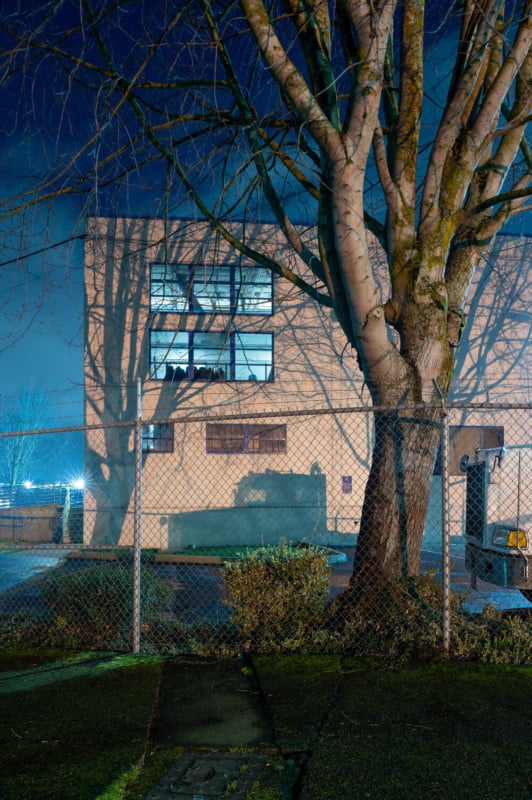
Despite having the D780 for a while, I didn’t have the chance to photograph with it under starlight conditions––mostly due to lunar phase timing while I had it in California and an extended period of overcast skies here in Vermont. I have used the Z 6 for astro-landscape photography, and it produces some of the best Milky Way images I’ve ever seen. Assuming that the D780 has the same sensor as the Z 6, albeit with a few tweaks in how the images are processed, then both are class-leading for astro-landscape imaging.
ISO Invariance
Like the D750 and D850, the D780 sensor is ISO-invariant, meaning that you can underexpose by several stops to preserve highlights and bring up the shadows in post-processing without majorly compromising overall image quality. This is likely due to the dual-gain sensor that has been featured in many of the best-performing cameras released in the last few years.
The pixels in dual-gain sensors have two readout modes, the first at native and modestly increased ISOs for maximum dynamic range, and another for lower noise at higher ISOs at the expense of dynamic range. The D850 high-ISO readout mode kicks in at ISO 1600. I have not been able to determine when it switches over in the Z 6 and D780, but it’s probably similar to the D850.
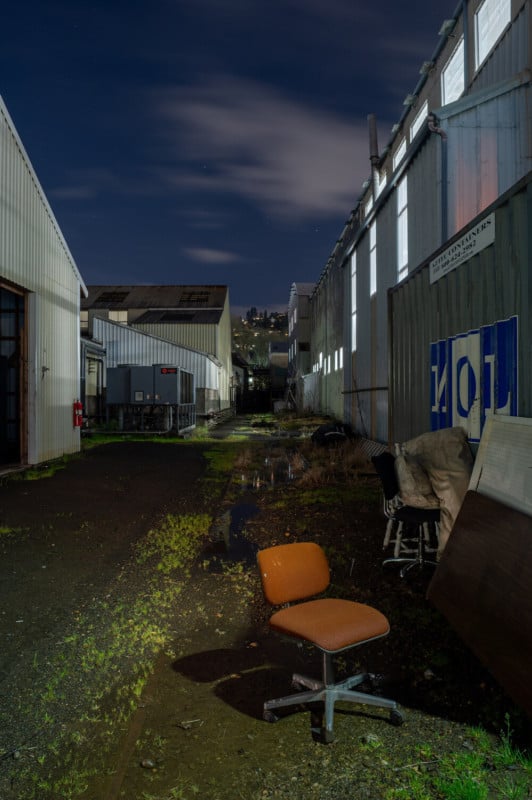
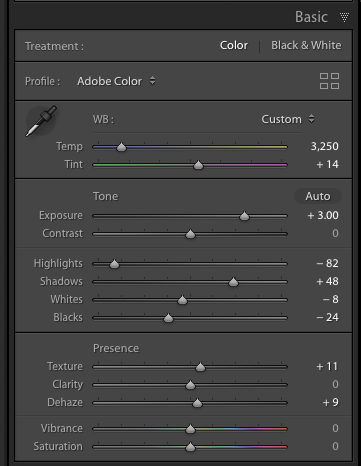
A Final Note on Image Quality
At the beginning of this article I mentioned a slight image quality improvement over the Z 6, and this has to do with the on-sensor phase-detection autofocus system. This is an advantageous feature, because it allows for phase-detection autofocus during live view. However, some of the pixel sites on the sensor are utilized for autofocus, which can cause a subtle banding effect in very deep shadows—especially when the exposure is raised in post-processing.
The D750 does not have this on-sensor system, and thus does not have this issue. The D780 does feature on-sensor phase-detection autofocus (the first Nikon DSLR to do so), but the banding issue has been resolved.
Conclusion
With so many great cameras to choose from, night photographers are not lacking for options. These days the debate is often about whether or not to make the switch from DSLR to mirrorless.
The D780 offers the best of both worlds in the form of a hybrid of the D750 and Z 6. The D780 has the phase-detection autofocus, the 4K video and the live view features of the Z 6 in a solid, compact DSLR body with a backside illuminated dual-gain sensor with great image quality at native, high and extreme ISOs. And don’t forget about the extended shutter speeds down to 15 minutes that virtually eliminate the need for an external intervalometer.
It’s not the perfect camera for night photography––we’re still waiting for that one, and likely always will be—but the D780 comes very close.
Many photographers have made the switch to mirrorless for the reduction in size and weight, and others have resisted the change because they are not ready to sacrifice their FX lenses or don’t want to deal with an adapter to use them. Personally, I prefer the user experience of the DSLR, and don’t feel that the modest decrease in size and weight of switching to mirrorless is worth the trade-offs. When I reviewed the D850 2 years ago, I concluded that upgrading from a D750 to D850 wasn’t worth it for me, as the primary benefit was increased resolution that I didn’t need and backlit buttons that were convenient but not worth the added cost or extra weight in my bag.
Now with the introduction of the D780, it’s once again time to consider an upgrade. I’m buying one.
Who is the Nikon D780 for?
D750 Owners
As one of Nikon’s most successful cameras ever, the D750 is hard to beat, though it is getting a little long in the tooth, having been released in 2014. With the D780, there’s a modest gain in image quality, especially at higher ISOs. However, most of the improvements have more to do with an updated user experience than better image quality. If you love your D750, but it has seen better days, or you are simply ready for an upgrade, you will not be disappointed with the D780.
Older Nikon Full-Frame Camera Owners
If you’ve been holding on to that D600, D610, D800 or even the D810, it’s time to upgrade. For D810 owners who need the higher resolution for huge prints, the D850 is probably a better choice for you.
Canon Shooters
Specifically, those who are dissatisfied with high ISO image quality, or struggle to use live view for focusing in the dark with their 5D Mark IV. Canon’s live view used to be one reason for a night photographer to choose Canon over Nikon. That changed with the inability to get a bright enough image for live view focusing with the 5D Mark IV and the greatly improved low-light live view performance in the Nikon Z 6, Z 7 and D780. The D780 has superior high ISO image quality for astro-landscape photography and wider dynamic range for urban night photography than any Canon camera.
APS-C Camera Owners
Yes, you. It’s time. It’s true that recent crop-sensor cameras do a much better job at high ISO than the older ones, but they cannot compare to the image quality of a modern full-frame sensor. For those on a budget, the D750 is still an outstanding value at $1,500. The $1,800 Z 6 is also a great option—it just depends on your preference for mirrorless or a DSLR. If you can afford it, get the D780. It’s worth the extra cost.
Z 6 Converts Who Love Their New Camera, But Miss Their DSLR
I know of at least one person who bought a Z 6 but switched to a D780 for this very reason. If I had bought a Z 6, I’d probably be in this category too.
Pixel Study: High ISO
I shot the same image on the same night with the same lens and settings to test image quality at high ISOs between the D750, D780 and Z 6. The images were made under clear, moonlit skies, and the subject was illuminated with a Luxli Viola on a light stand. The lighting was unchanged during the testing, except that the moon rose higher into the sky, which altered the shadows.
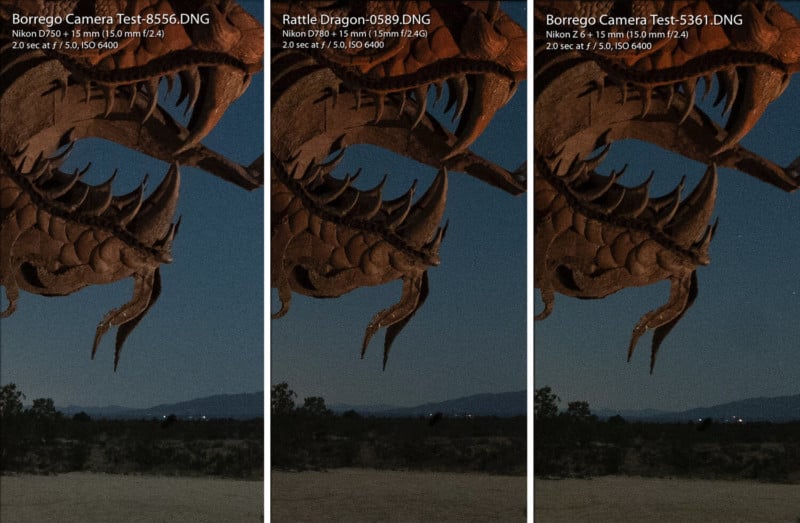
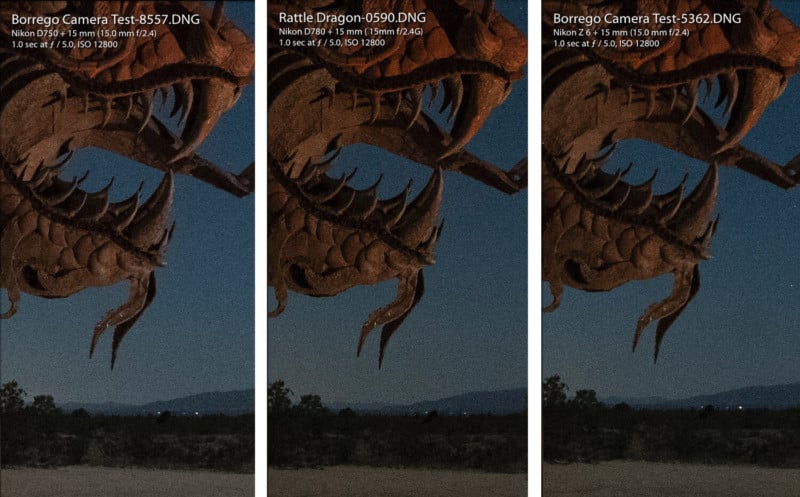
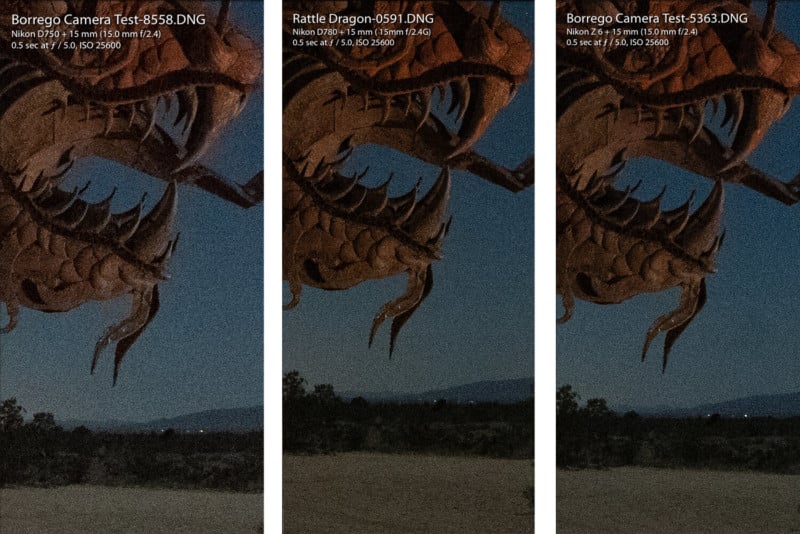
I tested each camera at ISO 6400, ISO 12,800 and ISO 25,600. There is very little difference between the three cameras at ISO 6400 and ISO 12,800, but the D750 image starts to deteriorate at ISO 25,600.
I also tested the D780 at ISO 51,200. At this extreme ISO, the image from the D780 deteriorates in the same way as the D750 does at ISO 25,600.
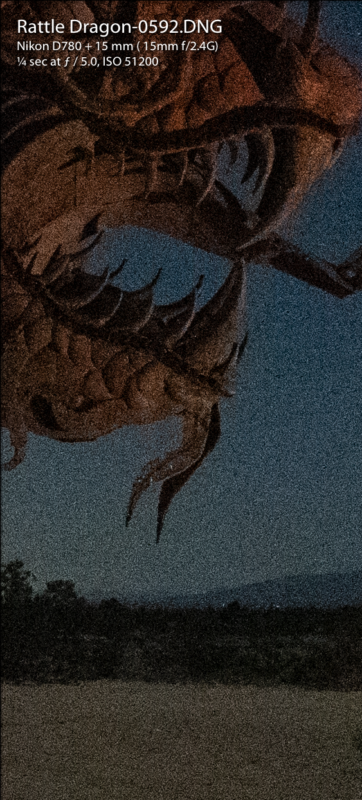
The colors start to bleed outside of contrast edges. Color noise is still easily managed by Lightroom’s default correction, and there is no sign of background pattern noise. Luminance noise is significant.
Download Test Images
So you can make your own evaluations, we are providing a selection of images made during the testing I did for this article at npan.co/D780testimages. They are mostly DNG files with embedded metadata. Feel free to download the files and manipulate them for evaluative purposes.
Warning: It might take awhile to download these, and we recommend not doing so with a mobile device using a cellular data connection. The files total nearly half a gigabyte.
About the author: Lance Keimig is a photographer and photography instructor based in Bristol, Vermont. The opinions expressed in this article are solely those of the author. Keimig is one of the instructors at National Parks at Night, a workshop program focused solely on teaching night photography in national parks. This article was also published here.
Image credits: All nighttime images are © 2020 Lance Keimig/NationalParksAtNight.com, and may not be printed or republished without express written consent of the author and National Parks at Night